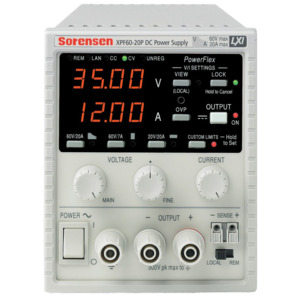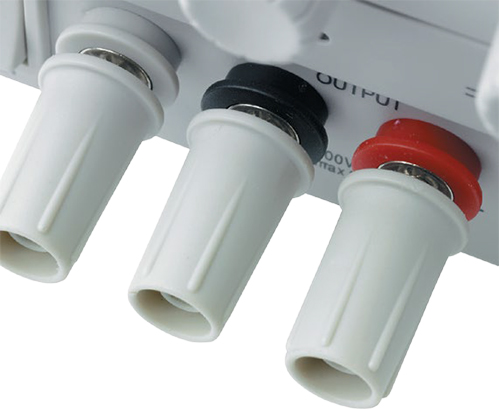
- Description
- Specifications
- Documents
Key Features
Voltage: 60V
Current: 10A - 20A
Power: Up to 420W per output (840W total)PowerFlex design provides higher currents at lower voltages enabling one model to meet many different voltage/current requirements.
Compact design for bench use or rack mounting (1/2 or 1/4 rack width)
True analog controls with digital settings locking (S-Lock)
Mixed-mode regulation with linear final regulation for low noise
Dual models have isolated voltage tracking and synchronous on/off.
Switchable remote or local sense
Constant voltage or constant current operation
P models have RS-232, USB, and LXI-compliant LAN interfaces plus duplicate rear terminals. GPIB Optional.

The Sorensen XPF is a new type of bench power supply designed to meet the need for flexibility in the choice of voltage and current. Typically, the maximum voltage and maximum current are not required simultaneously. The PowerFlex™ design enables higher currents to be generated at lower voltages within an overall power limit envelope. This is achieved by using the latest switch-mode technology.
The XPF60-20D are dual-output DC bench power supplies with two completely independent and isolated outputs. If required, the outputs can be wired in series or parallel to achieve up to double the maximum voltage or double the maximum current. The new XPF60-20S is a single-output version of the XPF60-20D providing 60V and 20A within its 420W power envelope.
The XPF Series benchtop DC power supply has advanced digital features while keeping its simple-to-operate analog controls.
The series also has a remote programming option making the popular XPF perfect for some ATE applications. Communication interfaces include LXI Class C Ethernet, USB and RS-232, and optional GPIB. Please see the XPF brochure section for the XPF60-20DP brochure which fully describes the advanced features.
Protection
Over-voltage protection per output
Switchable remote or local sense
Digital bus interfaces (XPF60-20SP, XPF60-10DP, XPF60-20DP only)
Sorensen XPF “P” models offer full remote control and read-back using RS-232, USB or LAN (compliant with LXI class C). Each bus interface provides full control of voltage, current, and output on/off, plus read-back of voltage, current and status. All interfaces are at ground potential and opto-isolated from the output terminals.
RS-232
Standard 9-pin D connector. Baud rate 9,600
USB
USB 2.0 connection (backwards compatible with USB 1.x). Operates as a virtual COM port
Ethernet (LAN)
Standard 10/100 base-T hardware connection. ICMP and TCP/IP Protocol for connection to Local Area Network or direct connection to a single PC.
LXI Compliance
LAN interface is compliant with LXI class C. (LXI is the abbreviation for Lan extensions for Instrumentation).

Model |
Channels |
Output |
Power |
Special Features |
|---|---|---|---|---|
XPF60-20S |
1 |
60V/20A |
420W |
- |
XPF60-20SA |
1 |
60V/20A |
420W |
Rear terminals, isolated analog remote control |
XPF60-20SP |
1 |
60V/20A |
420W |
LAN (LXI), USB, RS-232 |
XPF60-10D |
2 |
60V/10A |
360W |
- |
XPF60-10DP |
2 |
60V/10A |
360W |
LAN (LXI), USB, RS-232 |
XPF60-20D |
2 |
60V/20A |
840W |
- |
XPF60-20DP |
2 |
60V/20A |
840W |
LAN (LXI), USB, RS-232 |
Safety binding-post terminals
All XPF series power supplies are fitted with the new output terminals. As well as acting as conventional binding posts for bare wires, spade connectors, or standard 4mm plugs, these can accept a 4mm safety plug with rigid insulating sleeve, a requirement specified by an increasing number of laboratories for safety reasons. Limited opening length combined with raised insulated shoulders also make these terminals “touch proof” for voltages up to 250V.
Remote sense
Each output incorporates remote sense terminals that can be enabled or disabled at the flick of a switch. Remote sensing is essential for maintaining precise regulation at the load and true metering of the load voltage.
Low noise and good dynamic response
The PowerFlex regulation system used on the XPF Series combines a high frequency pre regulator with a linear post regulator to give both low noise and good transient response. Each output can operate in constant voltage or constant current mode with automatic crossover and mode indication.

